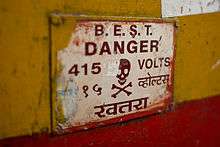Skull and crossbones (symbol)


| ☠ |
| Unicode character 'skull and crossbones' (U+2620) |
A skull and crossbones is a symbol consisting of a human skull and two long bones crossed together under or behind the skull.[1] The design originates in the Late Middle Ages as a symbol of death and especially as a memento mori on tombstones.
In modern contexts, it is generally used as a hazard symbol that warns of danger, usually in regard to poisonous substances, such as deadly chemicals.[2]
Unicode uses U+2620 ☠ SKULL AND CROSSBONES (HTML ☠)[3] for the symbol.
History of the symbol
The symbol is an ancient one, becoming widespread with the medieval Danse Macabre symbolism. By the 15th century the symbol had developed into its familiar form. From at least the 12thC it has been used for military flags or insignia, as a warning of the ferocity of the unit displaying it. It became associated with piracy from the 14th century onwards, possibly even earlier. The Knights Templar organisation, active from the 12th - 14th century, until their demise in 1307, adopted a skull & crossbones design marine flag to identify ships belonging to their vast fleet. [4] The later Knights of Malta, made up of many former Templars & using the same flag, became known for piracy. The skull and crossbones as a pirate's flag could well predate the Knights Templar [5]
It came to be used to mark the entrances of many graveyards [6] particularly Spanish cemeteries and also as an easily identifiable warning on poison and other dangerous liquid and powder containers since the 19th century. The Skull and crossbones were also popular on religious Crucifix made in Northern Europe during 18th and 19thC, worn on rosaries or as larger wall hangings in religious orders Memento Mori and symbolising Christ's victory over death. These crucifix were also placed on coffins during a funeral then later given to the deceased's family [7]
Military use
The skull and bones are often used in military insignia, e.g. in coats of arms of some military regiments.
Symbol for poison
In 1829, New York State required the labeling of all containers of poisonous substances. The skull and crossbones symbol appears to have been used for that purpose since the 1850s. Previously a variety of motifs had been used, including the Danish "+ + +" and drawings of skeletons.
In the 1870s poison manufacturers around the world began using bright cobalt bottles with a variety of raised bumps and designs (to enable easy recognition in the dark) to indicate poison, but by the 1880s the skull and cross bones had become ubiquitous, and the brightly coloured bottles lost their association.
As the skull-and-crossbones symbol has also entered popular culture in the context of piracy, and since cartoonish pirates have become popular characters with children, there have been concerns that the "poison" symbol might have the effect of attracting the curiosity of small children familiar with "pirates" as depicted as a toy or play theme. For this reason, in the United States there has been a proposal to replace the skull and crossbones by the "Mr. Yuk" symbol. However, Mr. Yuk and his graphic rendering are registered trademarks and service marks of his creator, the Children's Hospital of Pittsburgh of UPMC, and the rendering itself is additionally protected by copyright. This means that the name and graphic image cannot be used without a license from the owner—unlike the Skull and crossbones, which is in the public domain.
Gallery
 Stereotypical cartoon pirate sporting the skull-and-crossbones on his hat
Stereotypical cartoon pirate sporting the skull-and-crossbones on his hat Skull and crossbones as a charge in heraldry
Skull and crossbones as a charge in heraldry- An early 17th century "plague panel" from Augsburg.
See also
References
| Wikimedia Commons has media related to Poison warning signs. |
- ↑ "Dictionary and Thesaurus | Merriam-Webster". www.merriam-webster.com.
- ↑ "Dictionary and Thesaurus | Merriam-Webster". www.merriam-webster.com.
- ↑ "Skull and Crossbones Emoji". Emojipedia.
- ↑ https://www.bibliotecapleyades.net/sociopolitica/esp_sociopol_skullbones06.htm
- ↑ http://www.mysafetysign.com/poison-symbol-history
- ↑ http://freepages.genealogy.rootsweb.ancestry.com/~dicummings/ABCM/Religious%20Items.html
- ↑ http://www.rosaryworkshop.com/MUSEUM-CRUCIFIXES-MB-European.htm
.jpg)
